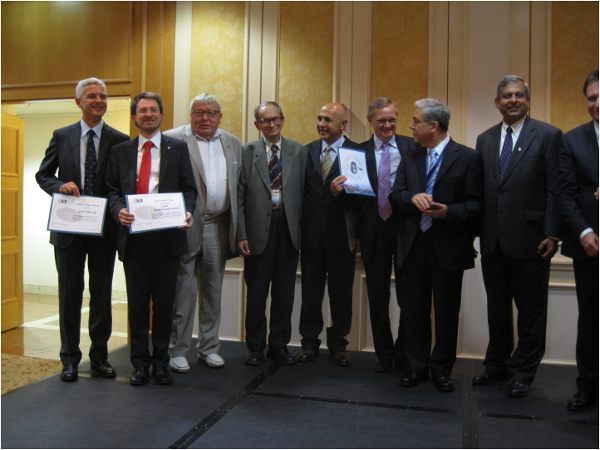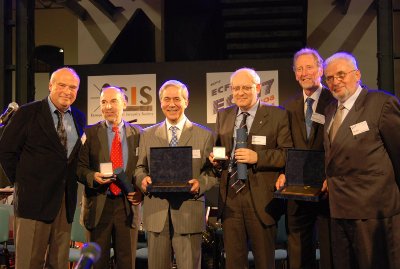ECF-13 conferences of ESIS
The awards announced on the following pages fall into two categories: the first is for awards associated with the biennial conferences of ESIS, in this instance the European Conferenceon Fracture (ECF-13) held in San Sebastian, Spain in September 2000. The awards are statutory insofar that they are approved by the ESIS Council and presented during the course of the conference. They include:
- The Griffith Medal
- The Wöhler Medal
- Award of Merit
- Honorary Membership of ESIS
- Young Scientist Award
It is not essential that all the awards be presented on every occasion of an ECF conference. However, in 2000, as in 1998 at ECF-12, a very strong list of candiates was offered to the ESIS Awards Committee, under the chairmanship of Professor Andre Pineau of France.
Professor Volodymyr Vasyliovych Panasyuk
|
Professor Volodymyr Panasyuk is Director of the Karpenko Physical-Mechanical Institute of the National Academy of Sciences of Ukraine, which is an internationally recognised scientific institute working on topical problems related to material mechanics and structural integrity, non-destructive testing and corrosion. Professor Panasyuk has largely contributed to the study of important problems, both from an industrial standpoint and from the viewpoint of an academic researcher. His original contributions to the problems of deformation and fracture of cracked bodies are well-known far beyond Ukraie. In particular, his work on the strip-yield model and COD behaviour, which coincided with independent work elsewhere, is now fully recognised throughout the world, particularly so in the international fracture mechanics community. Simultaneously with the publication of important monographs, Professor Panasyuk has developed a scientific school in the field of fracture mechanics and has largely contributed to research and teaching in the strategic field of activity. He is a Member of the National Academy of Sciences of Ukraine (since 1978), Doctor of Science (since 1967), Professor (since 1968) and a State Prize Laureate. Professor Panasyuk has publisehed more than 450 papers and 11 monographs and has supervised more than 40 PhD students and 10 Doctors of Sciences. The scientific and organising abilities of Professor Panasyuk are also weel-known, in particular his active participation in the activities of ESIS and his key role in the organisation of the Ukranian Society on Fracture Mechanics. In 1993, Professor Panasyuk organised the International Congress on Fracture – ECF8 held in Kiev. He was awarded the Diploma of the International Congress on Fracture Mechanics. He was also the ICF Vice-President during the period 1993-97. Griffith, who was the father of fracture mechanics, the originator of the multistage axial aeroengine and much else, would have been delighted to know that such a prolific contributor to fracture science has been awarded the ESIS Griffih medal. |
Professor Darrell F Socie
|
Professor Darrell Socie has worked on fatigue problems for 25 years, both from an industrial standpoint and from the viewpoint of an industrial researcher. His work began at the University of Illinois under the guidance of Professor Jo Dean Morrow and has continued from the basis of understanding cyclic stress-strain behaviour of metals through to understanding fatigue fracture processes, and thence onwards to widening knowledge of the behaviour of composite materials and ceramics. His contributions to scholarship, research and teaching have gone far beyond the shores of North America. He has made numerous visits to Europe, particularly Switzerland, Germany, Italy, Finland and France, and he has appeared at research seminars in the United Kingdom whee he has made several high-standard presentations to large audiences. His work not only covers all types of useful engineering materials, but also the interaction of different deformation and failure processes which necessitate a multi- and interdisciplinary approach, often requiring complex analytical and numerical solutions for three-dimensional stress-strain states ad non-proportional loading conditions. Professor Darrell Socie has now published a book entitled Multiaxial Fatigue, with Gary Marquis of Finland as co-author. Professor Darrell Socie is an internationally respected person both for his own work and for his committments to colleagues working in the field of fatigue. Among his many awards is the recent ASTM Award of Merit. Wohler would have been delighted to know that such a prolific writer of metal fatigue literature was a frequent visitor to Europe. |
Dr Ian Milne
|
In 1973, Dr Milne moved from work on type II superconductors for power transmission into the field of fracture mechanics, centering his work on material properties, and in particular their influence on structural integrity. He has written many papers on the transition behaviour of ferritic steels, on ductile tearing and on structural integrity analysis techniques. In this latter area, he was instrumental in developing the CEG procedure for integrity assessment which became known as the R6 procedure, and he led the R6 project until privatisation of the CEGB in 1990. He then moved into National Power and became the Controller of Power Technologies, and eventually Laboratory Head of what used to be CERL. He left National Power in 1992 and set up as an independent consultant. Dr Milne has been a member of EGF and ESIS since the late 1970s, and was a secretary of TC1 during its early period. He has made many contributions to technical debates within TC1 with such activities as organising round robins on structural integrity assessment. He has contributed to JRC Seminars held at Ispra, which were aimed at providing an advanced description of fracture mechanics methodologies so meeting the educational reponsibilities of ESIS (then EGF). He has appeared at most ECF meetings throughout this period and gave the introductory lecture at ECF6 in Amsterdam in 1986. In 1992 he was elected President of ESIS for the period to 1996, during which time he worked to advance the image of ESIS, especially within Eastern Europe. In 1996, on giving up the presidency, he was elected chairman of the publications committee. It was during this period that he began to realise that a more professional approach was needed to take ESIS into the 21st Centuryby, as a first step, the redevelopment of the ESIS Statues and By-laws. |
Professor Manuel Elices Calafat
|
ESIS Council unanimously approved the nomination of its Awards Committee to grant Honorary Membership of ESIS to Manuel Elices, this in recognition of his work in initiating in 1982, and then developing, the Spanish Fracture Group into an internatially respected organisation. Professor Elices graduated in Civil Engineering in 1963 and then in Physics in 1964. In 1966 he was awarded his PhD and is currently a Full Professor of Materials Science & Technology at the Polytechnic University of Madrid. His research work is primarily concerned with the mechanical behaviour of materials at very low and very high temperatures, in both theoretical and experimental aspects. He has published more than 300 scientific papers (half in international journals), 10 books and contributed chapters for another 10 books. An editor and/or associate editor of many international journals, together with membership of several national and international societies, he has been awarded a variety of prizes and awards including Bengough, Metals Society, DuPont, Spanish National Prize of Technological Research ‘Torres Quevedo’, Real Academia de Ciencias, Polytechnic University of Madrid and Honorary Fellowship of the Spanish Civil Engineering Association. |
Professor Gilles Perrin
|
Gilles Perrin is 35 years old. He is currently “Ingenieur de Recherche Principal” in the Applied Division of the French Petroleum Institute. He is also a Professor in the Department of Mechanics of the Ecole Polytechnique where he graduated in 1987. In 1990 he also graduated from the Ecole des Mines de Paris. His work began with modelling ductile fracture under the guidance of Professor Jean-Baptiste Leblond. He defended his thesis in 1992. Following this he was a visiting scientist at the Division of Applied Sciences of Harvard University, where he started to study earthquake mechanics under the guidance of Professor Jim Rice. From 1993 to 1997, he worked with the French Nuclear Safety Authority (DSIN). Gilles Perin has already recieved a number of academic distinctions, including: Proze L. Rivot of the French Academy of Sciences in 1987, Proze ‘Jeune Chercheur’ of Dret in 1993 and Prize Ernest Dechelle from the French Academy of Sciences in 1998. He has now published more than 15 papers in international journals with contributions to te analytical and numerical study of ductile fracture; in particular, the effect of a population of second phase particles on the growth of cavities, models for porous materials and improvements in Gurson-type models for hardenable materials. |
Table of content
Related articles
On the occasion of the 20th European Conference on Fracture in Trondheim, ESIS President Prof. Leslie Banks-Sills and ECF20 Chairman Prof. Zhiliang Zhang conferred the ESIS Awards. The Wöhler Medal was awarded to Prof. Reinhard Pippan for his seminal contributions to the effect of severe plastic deformation on fatigue. The Griffith Medal was awarded to Prof. Gordon Williams for[...]
On the occasion of the 18th European Conference on Fracture in Dresden, ESIS President Prof. Gdoutos and ECF18 Chairman Prof. Klingbeil conferred the ESIS Awards: Griffith Medal to Prof. E. Gdoutos ‘‘for his seminal contributions in mixed-mode fracture and failure mechanisms of sandwich structures”. Wöhler Medal to Prof. A. Saxena ‘‘for his outstanding and seminal contributions on[...]
ESIS President Prof. Gdoutos and ECF17 Chaimen conferred the ESIS Awards during the Social Dinner: - Griffith Medal to Prof A. Carpinteri, “for his outstanding theoretical results achieved in the field of fracture mechanics and their successful applications, especially those devoted to the improvement of structural integrity in civil engineering”; - Wöhler Medal to[...]









